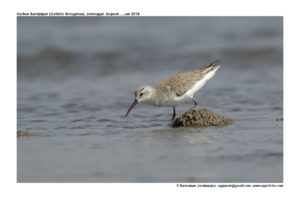Curlew Sandpiper

Curlew Sandpiper Calidris ferruginea
Etymology:
- Calidris : Greek word for grey-coloured waterside bird mentioned by Aristotle
- Ferruginea : Latin word for rusty-coloured,
Vernacular Names: Guj: Vankichanch, Shwethpithkhichdiyo, Ta: Mookuullan, Hindi: curlew Chaha, Mar: Kural/ BakchochTutari
Distribution in India: Winter Visitor to coasts of India. (Jamnagar is a good place to see it)
Description: Size of 18–23 cm; wt. of 44–117 g; wingspan 38–46 cm. It is a medium-sized sandpiper with longish neck and legs, and long bill. The head, neck and all underparts are rusty rufous to deep chestnut-red, with dark streaks on crown. The mantle and scapulars dark brown with chestnut and whitish fringes and wing-coverts are greyer. The female usually has longer bill; somewhat paler, with greater tendency to have white barring on underparts. The non-breeding adult is plain grey above, white below; has contrasting white supercilium and the sides of breast are washed grey. Juvenile like non-breeding adult, but upperparts brownish with whitish fringes; breast washed buff with little streaking.
Habitat: It breeds in lowlands of high Arctic, along coasts and on islands in Arctic Ocean, on open tundra with marshy depressions and pools. In winter it is found chiefly on coast, on muddy or sandy surface of tidal flats, coastal lagoons, estuaries and salt marshes; also inland, at muddy edges of marshes, large rivers, lakes, salt pans, irrigation schemes and flooded areas.
Food habits: It eats during breeding insects, including adults, pupae and larvae, especially of Diptera and beetles, bugs and leeches. It feeds by pecking and probing in wet marsh and peat. In non-breeding season it eats polychaete worms, molluscs, crustaceans, such as amphipods, shrimps and copepods, and sometimes insects and occasionally seeds. It picks prey from mud or sand surface or probes in mud, regularly wading in shallow. The worms usually washed before being eaten. It is diurnal and nocturnal. It is Gregarious outside breeding season, in flocks of up to several thousand.
Breeding habits: They breeds in Jun–Jul. The nest is built at margins of marshes and pools, on slopes of hummocky tundra or dry patches. They lay a clutch size of 3-4 eggs with laying interval of one day. The incubation period is 19–20 days and done by female alone. The chicks are cared by female alone and the fledging period is 14–16 days.